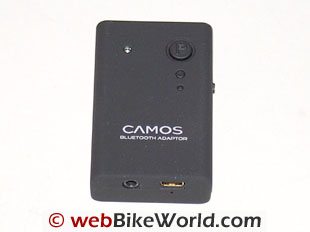It’s apparent from the many emails we have received on the topic that Bluetooth motorcycle intercoms are still in the early stages of development, with many problems not yet solved.
The recent IMC Camos Bluetooth stereo adapter article generated this dialog between the author, HBC, and an owner, I.F. and I thought it might also be of interest to others:
I.F.:
One thing about the BTA adapter you did not mention in your review is as soon as you pair it in radio mode (MONO) with BTS-300 it keeps open channel 1 forever.
That means, you are not able to listen to a music or hear navigation directions coming through A2DP channel 1. Basically, as long as BTA is connected to ch1 in MONO mode, nothing else can be paired with this channel.
The only workaround I found is you press T button on BTS-300 and it disconnects BTA and connects to another (previously paired) A2DP adapter (I personally have ComOne BT adapter attached to Garmin Zumo audio jack).
Then you can hear MP3 and navigation voice commands. If you need to use radio again, you have to press T button, and it reconnects to BTA (disconnecting from A2DP).
Unfortunately, if you disconnect from BTA using T button, it will not automatically reconnect in case there is an incoming call on 2-way radio. And you won’t notice if somebody is trying to call you!
Also: I think this behavior of BTA is done on purpose. If you used BTS-300 with Zumo’s build-in Bluetooth (MONO), you should’ve noticed the over problem. Zumo in contrast to BTA closes Bluetooth channel immediately (in 3 -5 sec. to be precise) after finishing audio transmission.
What happen next is when Zumo starts transmitting voice navigation command again, it take time to reestablish Bluetooth link with BST-300 and several seconds (sometimes ¾ of the voice direction!) get lost! I think, to avoid the same problem with BTA, they just force it to stay connected all the time.
I called Benchmark Helmets and they confirmed this issue with Zumo. They suggested a workaround, that might be interested to anyone who experience the same problem.
- Create a silent MP3 file.
- Upload it to Zumo memory stick.
- Play this silent file in a loop in Zumo MP3 player.
That will prevent Zumo from dropping Bluetooth link and eliminate the delay caused by reconnection of Zumo and BTS-300.
Interestingly, I also have a previous version of Camos headset – BHS-500 (single channel version of BHS-600). And it does not have this problem with Zumo! It does drop the Bluetooth link as well, but it reestablishes the connection in less than 1 second!
And BHS-500 does not have this annoying audio fade-in feature Camos introduced in their BTS devices. Thus, as soon as BHS-500 reconnects to Zumo the audio comes in full volume. In case of new BTS modules it takes an additional 2-3 second after reconnection to raise the audio volume to the preset level (“thanks” to fade-in feature!). These 2-3 sec. added to 4-5 sec. restoring BT link, and you lose the whole voice command completely!
BTW, the silent MP3 file trick eliminates fade-in problem as well.”
H.B.C.:
Channel One use with FRS radio and other audio source: As I identified in Part II, Configuration Seven, the BTA and radio combination does preclude the use of both a mono and stereo profile on Channel One for reasons that are not well identified in the BTS 300 manual or on-line, but actually in the small Radio and Audio BTA instructions included in that kit. Although they are obviously still written for the earlier BHS units, setup and use is pretty much correct with the BTS 300.
To address the comment regarding the channel being taken over or being kept open, I ran some further tests (the never-ending fun). If the BTA and Radio configuration is active, then an A2DP or stereo stream will not connect (tried it with three different phones), as others have found out as well.
Mono: I did find out that in reality, the Channel is not kept ‘open’ per se continually by the Radio link. After five seconds or so the white noise will fade somewhat, indicating that the link session has ended.
I.F.:
I’m not sure, maybe I have a defective BTA, but it never happens to me. There is ALWAYS white noise from BTA, it never disconnects from BTS-300, even if I do not attach radio to BTA at all (to avoid a threshold problem)!
HBC:
At that time I was able to once again hear the MP3 output and voice instructions being sent from the 2820 audio stream in mono…some of the audio session was still lost, but it was picking up. When I keyed the PTT switch or someone called me on the other radio, the GPS audio stream session would end, but resume (eventually) after the radio session was ended.
So, it seems possible that two mono or headset streams can be switched, but probably not reliably.
I.F.:
As far as I know, it’s impossible to connect two BT devices that use the same profile (headset, handsfree, etc.) to a third BT device channel at the same time. I tried to connect Zumo 550 build-in BT to BTS-300 while BTS was connected to BTA. And it messed up everything completely! I got exactly the same result trying this scenario with BHS-500. I even had to reset both BTA and BTS afterwards.
There is a notion of ‘Suspend/Resume’ BT device, but it’s only defined in version 2.1 + EDR. You can read about it in Bluetooth Core Specification. For my best knowledge none of the above devices implement this BT version.
HBC:
I have a hunch that if two of the Radio and Audio BTA units were used, both in mono mode (this BTA can be switched), that the switching between the two mono streams would be faster and perhaps more viable as a configuration and user option. This comment is once again based on the relative slowness of the Garmin BT, etc.
Using the ‘T’ button is not recommended for this type of control in any case, as it is pretty much reserved for telephone functions…I played around with this as well, as per the comments submitted and got the same results, whereas if I just waited an appropriate amount of time, one of the mono links would end and the other one resume.
I.F.:
I agree with that, but only if BTS-300 is paired with the phone. I my case, it’s paired with BTA and A2DP adapter, and I don’t see anything wrong with using ‘T’ button, especially, because it’s the only way to make things work.
HBC:
I am hoping that the BenchMark representative might provide some further insight as I know he has lots of experience in using the device as well and has been a continuing timely source of information.
HBC:
2. Channel One continuity with zumo 550 or similar device – I agree that the zumo 550 can be or is a problematic device to use with the BTS300. When used as the single BT (mono) connection there are typically no issues, but when it is asked to share Channel one, it can become sporadic and the switching delay is noticeable, which can typically result in some of the audio from the GPS being cut-off.
My measured average is two seconds to activate plus the fade in/out time (another 1 to 1.5 seconds) when transitioning between the A2DP stream and the zumo mono feed.
The other issue that crops up from time to time is that when the BTS 300 switches between the zumo and my HTC Touch, its a 50-50 chance whether the stereo stream will resume or whether I will have to start the MP3 player on the device again.
Another BT phone does the same thing, so the AVRCP protocol may be some of the culprit on one or both devices and the BTS 300 attempting to negotiate between the two profiles.
Adding the Garmin 2820 unit into the Channel one mix results in virtually the same switching and timing scenario as described for the zumo, although it seems the switching on the 2820 is a tad faster – I was losing less of the audio segments from the GPS. Another differential when using the 2820 is that the stereo stream would always resume, so I never had to start the MP3 player manually, curious?
On a personal note as a long time user of the zumo, the BT capability of the 550 poor anyway, so I don’t blame all the issues on the BTS 300. The BT on the 2820 is actually better for sensing previous connections or pairing up with a new device, and resuming a session.
I am hoping that the new zumo 660 will be a BIG step forward, it has A2DP and related protocols, and hopefully the speed will be there as well – it should be.
HBC:
3. Forcing mono channel to stay open – the issue with the zumo was identified by the BenchMark representative that I had been dealing with, and I can understand the principle behind the ‘silent’ MP3 file (this is a relatively well-used workaround for many audio issues and devices), but if you want to force the mono (profile) to remain open, then the user has to accept that this will be the dedicated stream.
My experience with the BTS 300 and the zumo has been that its single mono connection is very reliable and virtually no audio will be lost, as I noted above. Of course the silent MP3 file or any other audio above the threshold will keep the BTS 300 fade-in/fade-out process at bay if that is desired.
I.F.:
Not to me! (Owners of the) Zumo 550 know there is a button that can be pressed to repeat the last voice command. When Zumo is idle, it produces one of the following phrases: “Ready to navigate”, “Searching for satellite” or “GPS is off”.
In my case, the delay is so bad, that I DON’T HEAR A SINGLE WORD when I press this button and no ‘silent’ MP3 file is playing in the background. Again, do I have a defective BTS as well???
And some more words regarding BTA-100… I actually decided to return it. I could possible live with pressing ‘T’ button to switch between radio and A2DP (GPS/MP3). But I discovered a couple of other problems, that makes it completely useless for 2-way radio:
1. Incoming voice volume level is VERY low!
2. Outgoing voice level is even lower! But here I noticed an interesting thing. If I press PTT button on the radio itself, the outgoing voice level is 5x higher than I press a remote PTT button which came with BTA-100.
In both cases I speak through the same BTS-300 microphone! I tried it several times and the difference is amazing. While using BTA PTT button nobody can understand me (and it’s even not on the moving bike!). As soon as I press PTT button on the radio everyone hears me loud and clear.
Definitely looks like BTA-100 fault and not BTS-300, because I don’t have such a problem using BTS with a cell phone. I don’t know how good BTA is in stereo mode (did not try it), but the only reason I’ve bought it is to use with 2-way radios. And it failed badly.
HBC:
I will acknowledge there is a volume difference between using the PTT switch and the radio switch – that is normal, and on my configuration, the output was slightly higher only, not much at all.
I did find that setting the radio volume to around mid-range and doing the same for the BTS volume control helped level things out, but I know that might not work for every system.
The Motorola radios used in this configuration have been really good and they switch very quickly, which along with the fast-switching of the BT adapter, has made this a viable option, at least with the testing done and use so far.
Once we took some time to balance the volume controls between the devices, the comms link was a lot better, although I also have concerns over how audible everything will be at higher speeds, having only tested the radio link in local situation at nothing over 80km/h yet.
Given some of the other issues you have experienced, I would not rule out a possible BTA problem or even a defective or weak\ BTS system.
Garmin GPS and last command – our two zumo550 units have never been able to give us the ‘last command’…even though everyone says it will.
But in any case, I (still feel that) the zumo (has) a poor BT system…my 2820 disguised as a BMW Navigator III+ is far faster, will reconnect automatically, typically without any prompting, or with one button, it will go out and re-pair with anything in its menu that is within range…something the zumo struggles to do.
HBC:
Design and firmware issues: given some of the feedback received regarding the original systems, especially the two-chip to one-chip design and multi-channel facilitation, I can’t help wondering if real progress has been made across the whole capability baseline compared to the older models.
The switching on the BTS 300 is fast under most conditions, but it still seems (more) problematic as compared to user experiences with previous models and I know that some flexibility was lost in the transition from the older design to the new release.
I hope some of the above will address the questions posed, and perhaps shed some further light on some of the issues. Use of, and experimenting with the BTS 300 units is an ongoing activity, naturally.
Also In This Series:
▪ Part I: Camos BTS 300 Review
▪ Part II: Camos BTS 300 Configuration and Specs
▪ Part III: wiREVO BT Stereo Headset & Adapter Q&A
▪ Part IV: IMC Camos Bluetooth Adapter




